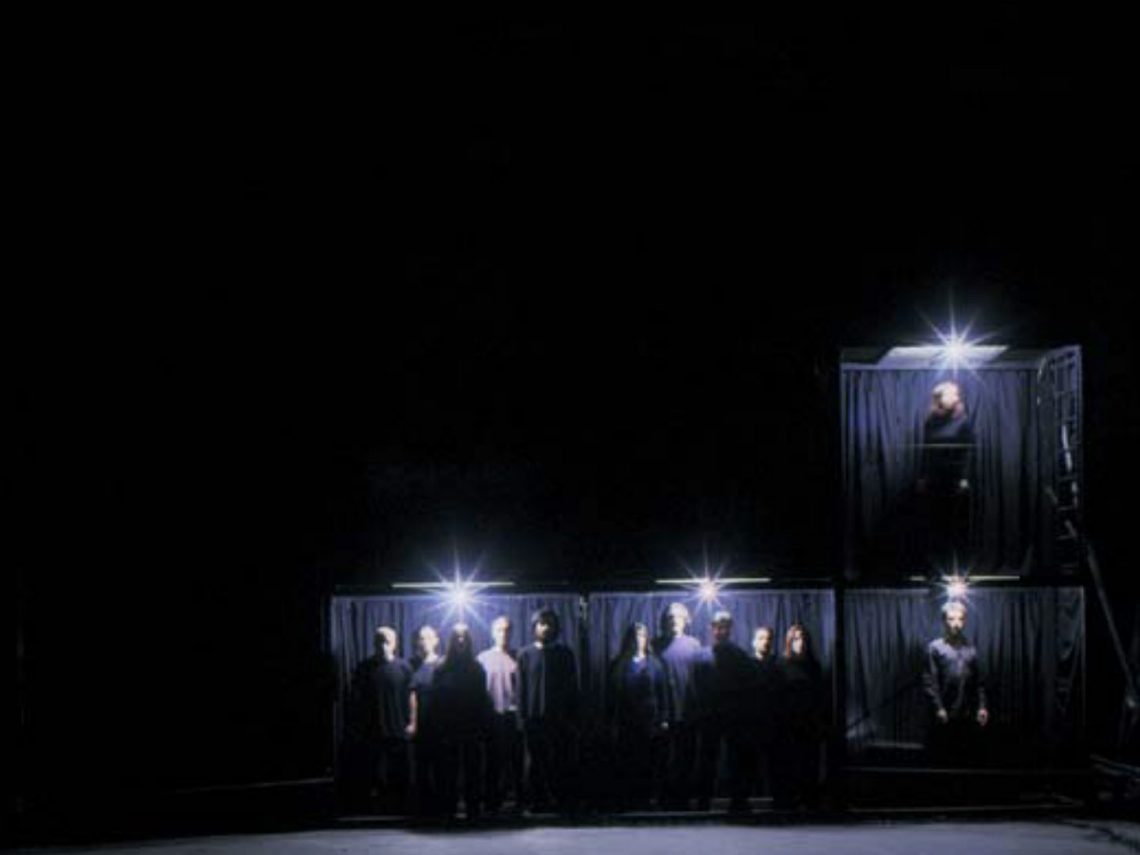Today’s human being lost his tragedy. Abandoned his grand projects, principles, faith, and lofty virtues. Gave up changing life, asking questions, wondering why. Rather preferred to “turn life into a game” by reconciling with life. This is the tragedy that the contemporary human being overlooks. In “Where Is Oedipus”, a real process of exploration is created in the order of a puzzle, for both the audience and Oedipus with the action of the lights and the actors, and with the synchronization of life/play/stage and human/role character/actor (by creating a simultaneous and synonymous reality). Life is questioned with a game, as opposed to “life being turned into a game”.
FROM THE DIRECTOR’S NOTES
- The play is performed in a large construction (box) of twelve transitive boxes placed on three transitive floors.
- This construction transforms the play area to two dimensional superficies.
- The construction (section of a scaena building, section of a doll house, crossword puzzle box, multivision monitors, television, computer monitor) is a play area that is formed by the rules which obligate the game to be played that way in real. It carries the qualification of a regular play area (game rule/ play area / player) that requires performative obligations.
- The play is in the order of a crossword puzzle and the players are directed by light.
- The crossword puzzle box is a simulation box which turns the destiny, that the human in life and the role characters in a tragedy are subjected to, into realty throughout the play, for the players. Thus three different layers, life/play/stage and human/role character/player, exist synchronously, simultaneously and synonymously.
- The crossword puzzle is formed by the mediation of the question in Sophocles’ tragedy, the crisis and the explanations; thus it is a way of performance to protect the detective form and the tension of the play. It constitutes both the destiny of Oedipus and the destiny of the player’s performance taking place in the present time on stage.
- The crossword puzzle is at the same time Oedipus’ weapon of power.
- The crossword puzzle is one of the most important factor in the legend that changes Oedipus’ destiny.
- The crossword puzzle is a design that obligates practically to ask questions and look for answers.
- Because of this reason, all the questions in the play text are emphasized, and the play is practically settled on these questions. The music of the language of the play is essentially defined by these questions.
- The light participates in the play just like a player and also symbolizes the enlightenment that comes with knowledge.
- As a result of the function of the light, the concepts of enlightenment and lighting reach a level of synchronization by meaning and practice.
- All other role characters appear with the illumination of the light and give information to Oedipus about “truth”. They carry the qualification of a clue, in a process common for both Oedipus and the audience, yet in different layers.
- The light generates a process of exploration for both Oedipus and the audience by lighting up the squares in an order of a crossword puzzle.
- The authority of the light is indisputable for the player. For this reason, by creating, without any condition, a realty in the player’s performance, a show process is created that makes the existence and the destiny of the role characters convincing.
- The movement of the light also symbolizes the contemporary information mediums such as the television, ways of receiving information such as the internet, and methods of receiving information which are performed and subjected to in the contemporary life such as misinformation, disinformation and zapping. It brings them into being practically by interrogating in the performance order that takes place in the present, by leaving it unfinished, by covering and by setting a trap.
- The play consists of three main episodes.
- The first episode synchronously symbolizes, tells about and realizes the transformation, the completion and reaching of an orderly play area- which is in disorder without any player inside- into a whole with an order, with the entrance of a player. In addition, this episode synchronously symbolizes, tells and realizes Oedipus’ relationship with the Sphinx, his entrance in Thebai, his coming to power both in the legend and in the tragedy.
- The second episode is the rearrangement of Sophocles’ “Oedipus the King” text, in the order of a crossword puzzle, yet by meaningly being attached to the very essence of an ancient tragedy application.
- The third episode is the “blind man’s buff” game played in the play box. It puts forth the main tragedy overlooked in the contemporary life, by telling how the life is turned into a game by the contemporary human who has lost his own tragedy, grand projects, faith and principles.




